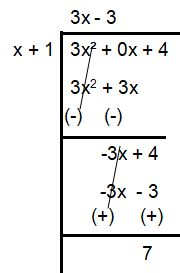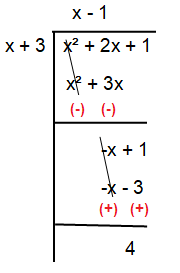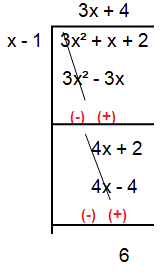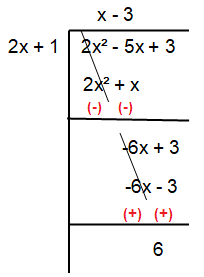PRACTICE PROBLEMS ON DIVIDING POLYNIMIALS FOR SAT
Problem 1:
The equation
is true for all values of x ≠ 2/3, where k is a constant. What is the value of k?
a.8 b.9 c.11 d.15
Solution :
= (5x + 8) - 4 / (3x - 2)
= (5x + 8) (3x - 2) - 4 / (3x - 2)
= (15x² - 10x + 24x - 16 - 4) / (3x - 2)
= (15x² +14x - 20) / (3x - 2)
(kx² + 14x - 20) / (3x - 2) = (15x² +14x - 20) / (3x - 2)
k = 15
The value of k is 15.
So, option (d) is correct.
Problem 2 :
The expression
(3x² + 4) / (x + 1)
is equivalent to which of the following?
a. (3x - 3) + 1 / (x + 1) b. (3x - 3) + 7 / (x + 1)
c. (3x + 3) + 1 / (x + 1) d. (3x + 3) + 7 / (x + 1)
Solution :

Writing the above in the form of
Quotient + (Remainder / Divisor)
we get,
(3x - 3) + 7/(x + 1)
So, option (b) is correct.
Problem 3 :
x³ - 3x² + 3x - 9 = 0
For what real value of x is the equation above true?
Solution :
x³ - 3x² + 3x - 9 = 0
(x³ - 3x²) + (3x - 9) = 0
x²(x - 3) + 3(x - 3) = 0
(x - 3) (x² + 3) = 0
x - 3 = 0 or x² + 3 = 0
x = 3
So, the value of x is 3.
Problem 4 :
What is the remainder when x² + 2x + 1 is divided by x + 3?
Solution :

Remainder = 4
Using the concept remainder theorem, we can find the remainder.
Let p(x) = x2 + 2x + 1
x + 3 = 0
x = -3
p(-3) = (-3)2 + 2(-3) + 1
= 9 - 6 + 1
= 10 - 6
= 4
Problem 5 :
When 3x² + x + 2 is divided by x - 1, the result can be expresses as
(ax + b) + c/(x - 1)
where a, b and c are constants. What is the value of a + b + c?
Solution :

3x² + x + 2) / (x - 1) = (3x + 4) + 6 / (x - 1)
Now comparing with
= (ax + b) + c / (x - 1)
Here a = 3, b = 4, c = 6
a + b + c = 3 + 4 + 6
= 13
So, the value of a + b + c is 13.
Problem 6 :
When 2x² - 5x + 3 is divided by 2x + 1, the result can be written as (x - 3) + R / (2x + 1), where R is a constant. What is the value of R?
Solution :

= (x - 3) + 6 / (2x + 1)
So, the value of R is 6.
Problem 7:
p(x) = (3x² - 5) (x + k) - 20
In the polynomial p(x) defined above, k is a constant. If x is a factor of p(x), what is the value of k?
a.-6 b.-4 c.2 d.4
Solution:
p(x) = (3x² - 5) (x + k) - 20
= 3x³ + 3kx² - 5x - 5k - 20
= x (3x² + 3kx - 5) - 5k - 20
If x is a factor,
Then -5k - 20 = 0
-5k = 20
k = -4
So, option (b) is correct.
Problem 8:
In the xy-plane, how many times does the graph of
f(x) = (x - 3) (x - 1) (x + 2)²
intersect the x-axis?
a.2 b.3 c.4 d.5
Solution :
f(x) = (x - 3) (x - 1) (x + 2)²
(x - 3) (x - 1) (x + 2)² = 0
x - 3 = 0 or x - 1 = 0 or (x + 2)² = 0
x = 3 or x = 1 or x = -2
The curve is intersecting the graph 3 times with multiplicity of -2 as 2.
Recent Articles
-
Finding Range of Values Inequality Problems
May 21, 24 08:51 PM
Finding Range of Values Inequality Problems -
Solving Two Step Inequality Word Problems
May 21, 24 08:51 AM
Solving Two Step Inequality Word Problems -
Exponential Function Context and Data Modeling
May 20, 24 10:45 PM
Exponential Function Context and Data Modeling